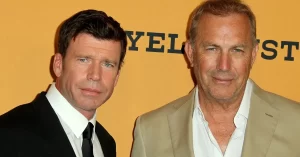In an absolutely staggering financial revelation that’s left both fans and industry insiders reeling, hit series Yellowstone has reportedly raked in an astonishing $700 million in total profit—despite suffering a $50 million loss during its tumultuous second season. This eye-popping figure has ignited widespread conversation not just about the show’s wild success, but also about the unpredictable economics of television production. The second season, while critically acclaimed and rich in drama, was apparently bogged down by inflated production c osts, unexpected delays, and behind-the-scenes disputes that drove budgets far beyond what was originally forecast. At the time, many insiders feared the show might falter under financial strain. But what followed was nothing short of a television miracle.
osts, unexpected delays, and behind-the-scenes disputes that drove budgets far beyond what was originally forecast. At the time, many insiders feared the show might falter under financial strain. But what followed was nothing short of a television miracle.
Created by Taylor Sheridan and starring Kevin Costner as the unrelenting patriarch John Dutton, Yellowstone quickly transformed from a Western-themed drama into a cultural juggernaut. While its second season struggled with costly location shoots, extensive reshoots, and rumblings of on-set conflict, it also laid the emotional and narrative groundwork that would catapult the series to historic highs in the years that followed. According to sources close to the production, Season 2’s ballooning budget included expensive action sequences, high-profile guest stars, and massive set builds—each decision justified at the time as necessary to compete in the ever-intensifying streaming wars.
Yet, rather than being its downfall, Season 2’s investment turned out to be the seed of something much greater. Viewership surged in Season 3, and by Season 4, Yellowstone was drawing more viewers than any other scripted cable drama in America. Merchandise sales exploded. Spin-offs like 1883 and 1923 pulled in even more viewers, further monetizing the Yellowstone brand. Licensing deals with streaming platforms, global syndication rights, and branded partnerships added hundreds of millions to Paramount’s revenue stream. Suddenly, the $50 million loss from Season 2 looked like a distant blip in an otherwise golden financial trajectory.
Behind the scenes, executives praised Taylor Sheridan’s long-term vision—even when it appeared risky. His insistence on cinematic scale, sweeping story arcs, and no-compromise performances meant the show resonated with audiences far beyond typical genre boundaries. Ranch life, land battles, and generational trauma became must-watch television. And as the series matured, so did its profitability. Analysts now point to Yellowstone as a textbook example of delayed financial gratification—proving that front-loaded investment, even at the cost of temporary losses, can yield enormous returns if paired with strong creative leadership and an engaged fan base.
But the financial revelation doesn’t come without intrigue. Industry insiders have questioned how such a significant loss went largely unnoticed by the public at the time. According to leaked documents and post-season audits, the losses were quietly absorbed by shifting funds within Paramount’s broader programming slate. Only now, years later, with full accounting from spin-offs and international licensing, has the true scale of the series’ profitability been exposed.
Fans have responded with awe and pride, flocking to social media to express their admiration for the series’ resilience. One fan tweeted, “They lost $50 million and still built an empire. That’s cowboy grit in action.” Another wrote, “Taylor Sheridan played the long game. And he won.” But others have raised concerns over how the massive profit is being distributed—especially considering rumored tensions between Costner and the studio over pay disputes and creative control.
Still, it’s hard to argue with the numbers. A $700 million profit places Yellowstone in the upper echelon of television franchises, alongside mega-hits like Game of Thrones and The Walking Dead. It also solidifies Taylor Sheridan’s place as one of the most powerful creative forces in Hollywood today. With new spin-offs on the horizon and no signs of slowing down, Yellowstone’s legacy is secure—not just as a cultural phenomenon, but as a financial powerhouse that beat the odds and rewrote the rules.
What this revelation also shows is the shifting landscape of television economics. In the streaming era, profitability is no longer tied exclusively to live ratings or initial ad revenue. It’s about brand expansion, viewer loyalty, and multiplatform integration. Yellowstone has mastered all three. From branded apparel and cowboy boot collections to prequel series and potential film spin-offs, the Dutton name has become its own industry.
In retrospect, Season 2’s $50 million loss feels more like an investment than a failure—a bold gamble that proved the power of vision, persistence, and trust in storytelling. While most networks would’ve balked at such a hit, Paramount doubled down. And they were right to. With a $700 million profit now proudly in the books, Yellowstone stands as a triumphant example of how smart risks can lead to extraordinary rewards in the entertainment world.
As the next chapter of the Yellowstone universe unfolds, with more stories to tell and more Dutton drama to unravel, fans can take comfort in knowing that the show’s foundation is as solid as the Montana soil it celebrates. Whether you tune in for the gunfights, the land deals, the family feuds, or the breathtaking landscapes, you’re watching one of the most profitable and impactful dramas in modern television history—and that’s a fact even more dramatic than the show itself.